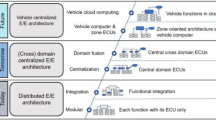Abstract
This paper puts forth a new approach for reducing the weight of a fuel cell (FC) powered fixed-wing unmanned aerial vehicle (UAV). The key innovation combines concurrent optimization of the FC and battery sizes along with their power management strategy. A particle swarm optimization (PSO) algorithm is leveraged to perform this concurrent optimization. Through these optimizations, reductions in weight are achieved for both the power sources and fuel tank, while maintaining optimized power output profiles. The optimization results demonstrate significant system weight reductions of 66.87% and 47.72%, for two distinct power profiles that were analyzed. Profile I corresponds to a smooth, continuous power demand over time, while Profile II is a fluctuant profile. In addition to weight savings, the power management optimization reveals an important interplay between the power profile demanded, control strategy, and sizing of the power sources. It was found that the FC is best sized to match the longest duration high power segment of the mission. This power-matched sizing results in stable, efficient operation of the FC over time. Conversely, the battery is sized sufficiently large to meet peak instantaneous power demands that exceed the FC capability. These findings showcase the potential of the proposed optimization approach to facilitate improved performance for electric fixed-wing UAVs. Moving forward, a series of numerical simulations validate the proposed methodology and confirm the deduced results.















Similar content being viewed by others
References
Duy VN, Kim HM (2020) Review on the hybrid-electric propulsion system and renewables and energy storage for unmanned aerial vehicles. Int J Electrochem Sci 15(6):5296–5319
Ganesan N, Sahoo BB, Ekambaram P et al (2022) Experimental based comparative exergy analysis of a spark-ignition honda gx270 genset engine fueled with lpg and syngas. Energy Sci Eng 10(7):2191–2204
Zhou Y, Ravey A, Péra MC (2020) Multi-objective energy management for fuel cell electric vehicles using online-learning enhanced markov speed predictor. Energy Convers Manag 213:112821
Mokhtar MA, ElTohamy H, Elhalwagy Yehia Z et al (2023) Developing a novel battery management algorithm with energy budget calculation for low earth orbit (leo) spacecraft. Aerosp Syst 1–15
Salehpour MJ, Zarenia O, Hosseini Rostami SM et al (2020) Convex multi-objective optimization for a hybrid fuel cell power system of more electric aircraft. Int Trans Electr Energy Syst 30(7):e12427
Wang B, Zhao D, Li W et al (2020) Current technologies and challenges of applying fuel cell hybrid propulsion systems in unmanned aerial vehicles. Prog Aerosp Sci 116:100620
Alulema V, Valencia E, Cando E et al (2021) Propulsion sizing correlations for electrical and fuel powered unmanned aerial vehicles. Aerospace 8(7):171
Reid WA, Albayati IM (2021) Design of an unmanned aircraft system for high-altitude 1 kw fuel cell power system. Aerosp Syst 4:353–363
Çınar H, Tunçel S, Kandemir I et al (2023) Conceptual design and optimal sizing of a small unmanned aerial vehicle with fuel cell and battery-powered hybrid propulsion system by meta-heuristic algorithms based on energy consumption. Energy Sourc Part A Recov Utiliz Environ Eff 45(1):140–159
Javidsharifi M, Pourroshanfekr Arabani H, Kerekes T et al (2021) Optimum sizing of photovoltaic-battery power supply for drone-based cellular networks. Drones 5(4):138
Mahmood LS, Shaaban MF, Mukhopadhyay S et al (2022) Optimal resource selection and sizing for unmanned aerial vehicles. Soft Comput 26(12):5685–5697
Arshad Z, Khoja AH, Shakir S et al (2021) Magnesium doped tio2 as an efficient electron transport layer in perovskite solar cells. Case Stud Therm Eng 26:101101
Karpovich E, Kombaev T, Gueraiche D et al (2024) Rocket-based versus solar wing-tail martian uavs: design, analysis, and trade studies. Aerosp Syst 1–15
Boukoberine MN, Donateo T, Benbouzid M (2022) Optimized energy management strategy for hybrid fuel cell powered drones in persistent missions using real flight test data. IEEE Trans Energy Convers 37(3):2080–2091. https://doi.org/10.1109/TEC.2022.3152351
An JH, Kwon DY, Jeon KS et al (2022) Advanced sizing methodology for a multi-mode evtol uav powered by a hydrogen fuel cell and battery. Aerospace 9(2):71
Liu H, Yao Y, Wang J et al (2022) Energy management and system design for fuel cell hybrid unmanned aerial vehicles. Energy Sci Eng 10(10):3987–4006
Kaptsov M, Rodrigues L (2021) Flight management system for hydrogen-powered aircraft in cruise. Aerosp Syst 4(3):201–208
Han K, Qian H, Zhang Q et al (2019) Optimization of energy management system for fuel-cell/battery hybrid power in unmanned aerial vehicle. In: 2019 22nd international conference on electrical machines and systems (ICEMS), pp 1–6. 10.1109/ICEMS.2019.8921655
Saib S, Achour Y, Ghennam T et al (2023) Design optimization and power management of a fuel cell-battery fixed-wing electric UAV. Proc Inst Mech Eng Part G J Aerosp Eng
Karunarathne L, Economou JT, Knowles K (2012) Power and energy management system for fuel cell unmanned aerial vehicle. Proc Inst Mech Eng Part G J Aerosp Eng 226(4):437–454
Cheng Z, Liu H, Yu P et al (2021) Energy management for fuel cell/battery hybrid unmanned aerial vehicle. Int J Electrochem Sci 16(10):1–17
Funding
The authors declare that no funds, grants, or other support were received during the preparation of this manuscript.
Author information
Authors and Affiliations
Contributions
Conceptualization: [Nassim Rizoug, Sabah Saib, Yahia Achour]; methodology: [Sabah Saib, Yahia Achour]; writing—original draft preparation: [Sabah Saib]; writing—review and editing: [Yahia Achour, Sabah Saib, Khoudir Marouani, Tarak Ghennam].
Corresponding author
Ethics declarations
Competing of interest
The authors have not disclosed any competing interests.
Rights and permissions
Springer Nature or its licensor (e.g. a society or other partner) holds exclusive rights to this article under a publishing agreement with the author(s) or other rightsholder(s); author self-archiving of the accepted manuscript version of this article is solely governed by the terms of such publishing agreement and applicable law.
About this article
Cite this article
Achour, Y., Saib, S., Rizoug, N. et al. Optimal power management and sizing of a fuel cell electric UAV. AS (2024). https://doi.org/10.1007/s42401-024-00285-2
Received:
Revised:
Accepted:
Published:
DOI: https://doi.org/10.1007/s42401-024-00285-2




